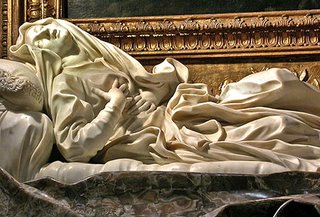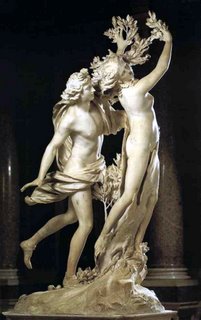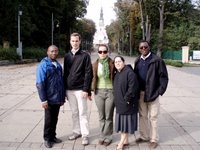
Shortly after Gerald Ford’s death, recent interviews that had been conducted with the president were disclosed. The interviews cover a wide-range of subjects, but a good deal of time is devoted to the late president’s critical view of what he saw as the rightward tilt of the Republican Party. Not surprisingly, the media has been unrelenting in their focus on Ford’s harsh appraisal of the GOP and President Bush. Watching moments of the funeral last night, I lost count of how many times smug commentators reminded viewers of Ford's opposition to the Iraq war. In case anyone missed the point, Ford opposed the war. Today, I came across a a recent Newsweek article that discusses Ford’s outlook. My thoughts on each observation are included.
"As he grew older, he also increasingly moved to the center. He was privately critical of Bush's Iraq war and was also surprised by Cheney's growing hawkishness. He has been quoted criticizing President Bush's Iraq war, and marveled to friends that Cheney had grown so much more hawkish…what stands out most from our talk was Ford's frustration that the Republican Party had lurched so far to the right. 'If I'd been elected in '76,' he told me flatly, 'the party wouldn't be as far right as it is at the present time … I sure hope it comes back to the center.'"
This is, quite frankly, not a very profound or intelligent observation by either Newsweek or Ford. As a general rule, losers in politics are not the first group of people I would go to for advice on how to guide a Party to success, but this trend seems to be a popular one in DC; for Democrats still worship the flop of a president Jimmy Carter. As far as Republicans go, Ford had integrity, but as a leader, he was not much better than the disasterous Carter. He was not elected in ’76 for many reasons. No doubt, his judicious pardon of Nixon contributed to his defeat but it was not the only reason for his demise. His mediocre, bland style of Republicanism was not appealing to the base of the Party. In short, he was rejected by his own. He was a decent man but certainly not an inspirational leader. It is typical for Republicans of Ford’s mold to lambaste fellow Republicans who embrace the traditional values and convictions of their base as “extreme”, “right-wingers” or “hawkish”. The truth is that, whenever Republicans have tried to move to the “center” (msm parlance for becoming liberal) they have their clocks cleaned in elections. In positioning themselves in the center, they abandon the principles of the Conservative movement. Whenever they stake their candidacy on the traditional issues of the Conservative movement (limited Federal government, pro-life, pro-tax cuts, pro-free-market, etc.), they win convincingly. So, move to the center and lose or hold fast to the core convictions of the base and win. What is a Republican to do? Reagan was one of the greatest presidents for many reasons, chief among them because he saw himself as the leader of a clearly defined movement, born of a well-thought out philosophy of government; a movement that was rooted in core principles that were plainly distinguishable from the other side. He defined the Conservative cause and he defined the opposition, drawing a line to mark the differences. He was very outspoken in favor of life, he favored tax cuts and he was not in the least afraid to project the might of America’s unrivaled military into the face of threats to our national security around the globe. He viewed the world in black and white, good and evil. The United States is not perfect, but it is still one of the world’s greatest forces for good. Reagan, in a certain sense was the anti-Ford, and history has vindicated Reagan’s vision for the Republican Party and the United States.
The article goes on…
"He (Ford) criticized Bush Senior's public avowal that he had come to oppose abortion rights. 'I know damn well that he and Barbara are pro-choice,' Ford told me. 'Why didn't they get up and say it? That really disappointed me more than anything.' Ford's comment, Bush says, was off the mark. 'That's wrong,' he says of Ford's suggestion that Bush was secretly pro-choice."
This vignette offers an unfortunate glimpse into Ford’s acerbity. He brazenly questioned the sincerity of President George H. W. Bush’s pro-life convictions. The unwarranted aspersion against Bush Sr. smacks of petulancy emanating from Ford and contributes to the construction of an image of a disgruntled and aged former president who really has no outstanding legacy of his own and has been reduced to unleashing withering critiques of friends.
Continues the article…
"Ford said that during his fall campaign against Jimmy Carter, 'the only time [Reagan] appeared with me … was when … we had a nice, vigorous rally [at a fund-raising dinner] in Los Angeles … He made no other campaign appearances on my behalf … I never understood that. If he had made an appearance in Ohio … Louisiana and Mississippi, we would have won, I'm sure.' A tough-minded politician, he was a decent man who came to symbolize an American longing for bipartisanship and courage. We may marvel that Ford could remain so good-hearted amid such a toxic political environment."
One simply cannot imagine Reagan or even Bush Sr. whining about the past in the manner of Ford. It must have been difficult for a politician of Reagan’s unmatched caliber to psych himself up with regards to Ford’s floundering presidency and, subsequently, the prospects for his election in ’76. It is also somewhat curious that these critical interviews took place under the condition that they be made public only after Ford’s death. Indeed, what was he afraid of? Why wait? If he was so upset about the direction of his Party, why not make reform a top priority? Ford was an honest, well-respected man. His insights surely would have been taken seriously. But instead he chose to have the full force of his opinions released in concert with his permanent departure; it does not reflect well on the man. The media’s gushing over Ford’s criticism of Bush is difficult to bear; there is nothing they like more than to see a self-described Republican lay hard into President Bush. In some way, it vindicates their own insufferable prejudices against the man. The bottom line is that Ford was a man of integrity but was certainly not a great President, or even a very good one. He utterly lacked vision for the country and, being a moderate (liberal) Republican, he was a politician without a home and thus explains his failure as president to win election. The country waited out his and Carter’s listless reigns in expectation of a real leader. The waiting paid off with the arrival President Ronald Reagan. President Bush, despite his foibles, has governed as a Reaganite Conservative on social issues; the very issues Republicans like Ford find so troubling and threatening to the future of the Party. Predictably, Bush was reelected, just like Reagan. There is a strong mandate for conservative issues in America. Republicans who recognize this fact have succeed and will continue to succeed. Republicans, like Ford, who do not accept this have lost, and will continue to lose.





























